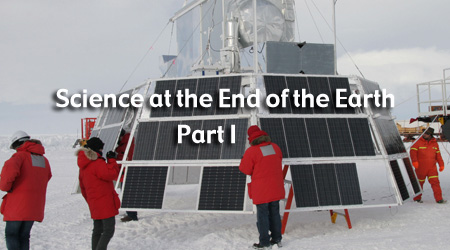Podcast: Science at the End of the Earth, Part I
- By Sara Mitchell
- December 31, 2009
- Comments Off on Podcast: Science at the End of the Earth, Part I

Click to listen! (7MB MP3, right-click to save)
Transcript (Text, PDF)
Hunting for antimatter requires a serious expedition. Scientists aren’t looking for run-of-the-mill particles – they’re collecting cosmic radiation that could be the signature of primordial black holes or other forms of dark matter. With instruments suspended from enormous scientific balloons, they’re looking for a launch site that offers long orbits and lots of particles to detect. Where’s one of the best places in the world to go particle hunting? Over the remote Antarctic continent!
To find out more about Antarctic scientific ballooning, we talked to Dr. John Mitchell, the lead scientist on BESS (the Balloon-borne Experiment with a Superconducting Spectrometer), a joint Japanese/US project that is studying antimatter in cosmic radiation. BESS has flown twice from Antarctica, and a team is headed back this month to recover their detectors from the last flight. We caught Dr. Mitchell just before he left for his latest Antarctic adventure. And no, the last name is not a coincidence – Dr. Mitchell is Blueshift producer Sara Mitchell’s father!
Part II of “Science at the End of the Earth”
NASA and Scientific Ballooning
Scientific balloons are an alternative to satellites for some NASA projects – they cost less, are easier to launch, and often allow researchers to recover their hardware for future refinement and re-flight. To learn more about ballooning, visit:
- NASA’s Scientific Ballooning Program supports a variety of instruments flown on balloon payloads to study the Earth and space.
- Columbia Scientific Balloon Facility (CSBF) provides launch services for scientific balloons flown in Texas, Antarctica, and other locations around the world.
- Learn more about McMurdo Station and the history of Antarctic ballooning.
- In January 2009, we shared the story of a mysterious radio signal detected by ARCADE, another NASA balloon mission that launched from Texas.
More About BESS
BESS (the Balloon-borne Experiment with a Superconducting Spectrometer) has been launched twice (in 2004 and 2007) from Williams Field at McMurdo Station in Antarctica. To find out more about the project, check out these sites:
- The Astrophysics Science Division mini-site for BESS (including a small gallery of images from hardware testing and launches)
- The BESS Homepage developed by the program’s Japanese collaborators
- A press release from the National Science Foundation about the record-breaking concurrent launches of three cosmic ray balloons in 2007, including BESS
Credits:
| Host | Sara Mitchell |
| Guests | John Mitchell |
| Interviewers | Sara Mitchell |
| Editor | Sara Mitchell |
| Theme Music | Naked Singularity |
| Transcript | Eric Winter |
| Website Support | Meredith Gibb Maggie Masetti |
| Producer | Sara Mitchell |
| Responsible NASA Official | Kim Weaver |


